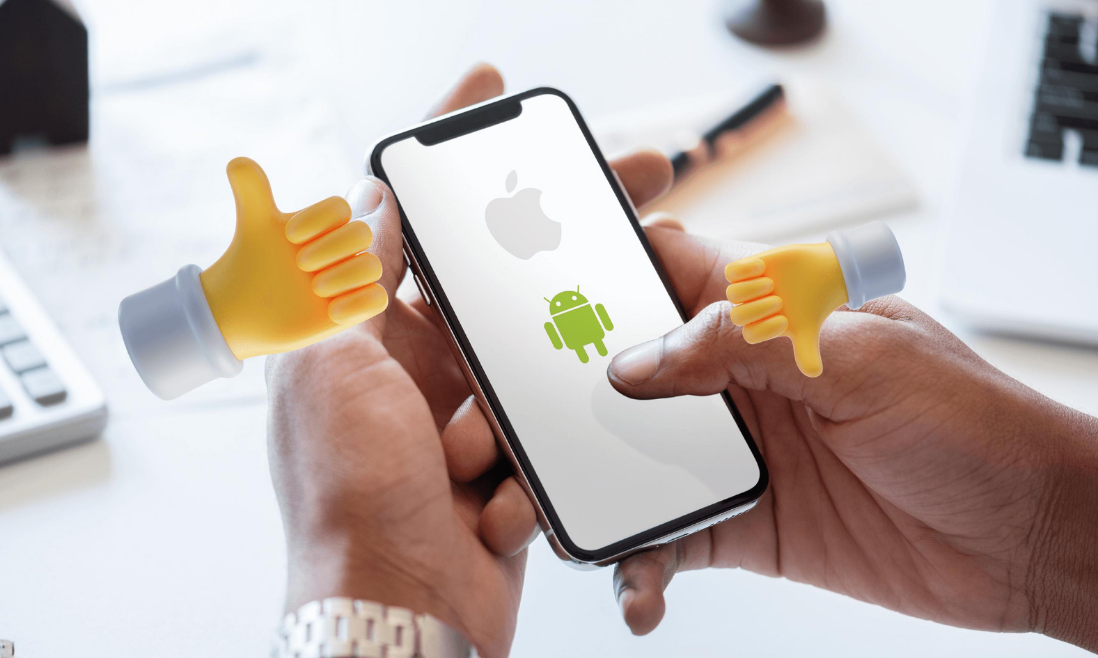In this post, we’ll delve into the nuances and distinctive features of Native Apps, Hybrid Apps, and Progressive Web Apps (PWAs). Each of these app types offers unique advantages and limitations, tailored to different development needs and user experiences.
This table serves as a quick reference to help you grasp the fundamental aspects of each app type at a glance:
| Criteria | Native App | Hybrid App | Progressive Web App (PWA) |
|---|---|---|---|
| Technology Used | Platform-specific languages (Swift for iOS, Java/Kotlin for Android) | Combination of web technologies (HTML, CSS, JavaScript) and native elements | Web technologies (HTML, CSS, JavaScript) |
| Performance | High (optimized for specific platform) | Good, but generally lower than native apps | Varies, generally good but can depend on browser and device |
| Device Feature Access | Full access to device features and capabilities | More than PWAs but less than native apps | Limited compared to native and hybrid apps |
| Development & Maintenance | More resource-intensive, separate codebase for each platform | Less resource-intensive than native, single codebase for all platforms | Less resource-intensive, easier updates (single web-based codebase) |
| Distribution | Through app stores (Apple App Store, Google Play) | Through app stores, similar to native apps | Directly via web, no app store distribution |
| Offline Capabilities | Strong (can offer comprehensive offline functionality) | Moderate (depends on implementation) | Available (limited compared to native apps) |
| User Experience | High (smooth and responsive, adheres to platform UI standards) | Good, but can vary across devices and platforms | Varies, aims to mimic native app experience |
| Search Engine Discoverability | Not applicable (apps are not indexed by search engines) | Not applicable (apps are not indexed by search engines) | High (PWAs are indexed by search engines) |
Now, let’s take a closer look at each type and dissect their key characteristics. Whether you’re aiming for the high performance and rich features of native apps, the cross-platform flexibility of hybrid apps, or the accessibility and ease of maintenance of PWAs, this blog will guide you through making an informed decision for your next app development venture.
Contents
Native Apps

Native apps represent a prominent approach. These apps are specifically tailored for individual platforms, such as iOS or Android, employing the native programming languages and development tools unique to each.
This method is widely considered the pinnacle of mobile app development due to its ability to fully harness the capabilities of the targeted platform, leading to high-performance applications that seamlessly integrate with the device’s native features.
Pros
Let’s explore the key pros that set native apps apart, underlining why they are often the preferred choice for developers and users alike.
- Optimized Performance and User Experience: Native apps are inherently faster and more responsive. They are designed and optimized for specific hardware and software, allowing for seamless integration and smoother operation. This results in an enhanced user experience, characterized by quick load times and high responsiveness.
- Full Access to Device Features: With native apps, developers can fully utilize the device’s capabilities, such as the camera, GPS, and push notifications. This access not only boosts the app’s functionality but also enables richer, more engaging user interactions.
- Access to Latest OS Features: Developers working on native apps have access to the latest software development kits (SDKs), allowing them to integrate new features and apply bug fixes promptly.
- Enhanced Security: By leveraging the inherent security features of the platform, native apps generally offer better security compared to their cross-platform and hybrid counterparts. This is crucial for apps dealing with sensitive information.
- Ease of Deployment and Discovery: Submitting native apps directly to app stores like Google Play and the App Store enhances their discoverability and simplifies the installation process for users.
- Quality Assurance and Compatibility: The requirement for approval by respective operating systems, such as iOS or Android, acts as a quality check. This ensures better compatibility with devices and a refined user experience.
- Marketing Opportunities: Being available on prominent platforms like the App Store and Google Play Store provides excellent visibility and marketing opportunities for your app.
Cons
While native apps boast numerous benefits, it’s important to acknowledge their drawbacks. Here’s a closer look at the cons of native app development:
- Higher Cost and Time Investment: Developing native apps is generally more expensive and time-consuming. Since these apps require a unique codebase for each platform, developers often have to build separate versions for iOS and Android. This duplication in development efforts leads to increased costs and longer timeframes for market launch.
- Need for Specialized Skills: Native app development demands programming skills specific to the platform (iOS or Android). This usually necessitates a team of experienced developers, which can be a resource-intensive requirement, especially for smaller organizations or individual developers.
- Limited Code Reusability: One of the significant drawbacks of native apps is the limited ability to reuse code across platforms. Each platform requires its own codebase, which can lead to increased development time and higher maintenance costs.
- Complex Maintenance: Maintaining native apps can be a complex and resource-intensive task. Each platform update or bug fix must be handled separately, potentially leading to increased workload and the need for specialized expertise.
- Compatibility Challenges: Despite being designed for specific platforms, native apps are not immune to compatibility issues. They may face challenges with new device versions or updates to the operating system, requiring ongoing vigilance and updates to ensure smooth operation.
Who Should Consider Native App Development?
Native app development is most suitable for specific scenarios and business needs. Here’s a breakdown of when opting for a native app is the ideal choice:
- High Performance and Specialized Features: If your project demands high-speed, responsive interactions, particularly for applications that require real-time processing or extensive use of device hardware capabilities, native apps stand out. They are also the go-to choice for projects needing to leverage device-specific features like cameras, sensors, or GPS.
- Targeting a Specific Platform: When your app is primarily aimed at either iOS or Android users, native development ensures it is perfectly tailored to that platform, offering the best possible user experience and performance.
- Dealing with Sensitive Data: For apps handling sensitive information or financial transactions, the enhanced security measures provided by native apps are crucial. They utilize the full security capabilities of the underlying platform, offering more robust protection than their hybrid or web counterparts.
- Long-Term Scalability and Growth: Businesses with a long-term vision for their app, expecting it to evolve and grow over time, will find native apps more accommodating. They are better suited for scalability and can adapt more readily to future development needs.
- Available Resources and Expertise: Given the higher development costs and the need for specialized skills, native app development is ideal for those with the necessary budget and access to skilled developers proficient in platform-specific programming languages and tools.
Conversely, native app development might not be the best route in situations where budget constraints are tight, the need for cross-platform compatibility is high, or the app’s functionality is simple and doesn’t require deep integration with device capabilities. In these cases, exploring hybrid apps or PWAs could be more beneficial.
Hybrid Apps

Hybrid apps represent a unique blend in the world of mobile application development, combining elements of both native and web applications. This approach involves using web technologies—HTML, CSS, and JavaScript—to create the core of the app, which is then encapsulated within a native container.
Pros
Hybrid apps combine the best of both worlds – the cost-effectiveness and versatility of web apps with the performance and user-centric features of native apps. Here’s an overview of the key advantages this approach brings:
- Efficiency and Cost-Effectiveness: One of the standout benefits of hybrid apps is their ability to utilize a single codebase across multiple platforms, such as iOS and Android. This unified approach not only streamlines the development process but also significantly reduces the time and resources needed compared to building separate versions for each platform.
- Cross-Platform Reach and Audience Engagement: Hybrid apps excel in their ability to reach a broader audience across different platforms. By enabling deployment on various mobile platforms with one unified codebase, these apps can tap into a wider user base, maximizing the app’s reach and impact.
- Flexibility and Rapid Market Entry: Hybrid apps support rapid prototyping and testing, which allows for faster iteration based on user feedback and market trends. Additionally, their compatibility with web services and APIs makes them highly adaptable, leveraging existing backend infrastructures.
- User Experience and Performance Enhancements: Despite their web-based origins, hybrid apps are capable of offering an experience that closely mirrors that of native apps. They can provide offline functionality, allowing users to access content and perform certain actions without an internet connection.
Cons
Hybrid app development, while offering a range of benefits, also brings with it several challenges and limitations that are crucial to consider before embarking on this path.
- Performance and User Experience Drawbacks: A notable concern with hybrid apps is their performance, which often lags behind that of native apps. Additionally, achieving a user experience that feels native on each platform can be more challenging. Hybrid apps may not always be fully optimized for the specific hardware and software nuances of different devices.
- Complexity in Development and Maintenance: Bug fixing in hybrid apps can be more complex than in native development, as issues may arise from both the web and native components of the app. Additionally, hybrid apps tend to be less customizable than native apps.
- Design and Interface Consistency Issues: Hybrid apps may struggle with maintaining consistency in design and user interface across different platforms. Since they are not built with platform-specific guidelines in mind, the result can be a user interface that lacks the polished feel of a native app.
- Security and Feature Accessibility Concerns: Hybrid apps are susceptible to web-based vulnerabilities and rely on third-party plugins for accessing native features, which can introduce additional security risks.
- Dependence on External Platforms and Tools: The reliance on third-party platforms for deploying hybrid apps introduces a level of dependency that can be restrictive. These external platforms may limit the app’s functionality, and any changes or updates in the platform can directly impact the app’s performance and capabilities.
Who Should Consider Hybrid App Development?
Hybrid app development offers a unique set of advantages that make it an attractive choice for specific project types and objectives.
- Simple, Content-Based Projects: Hybrid apps are ideally suited for simple, content-focused projects. This includes applications centered around content delivery like news, educational materials, or basic productivity tools such as note-taking and task management. Their ability to efficiently handle content without the need for complex features or animations makes them a practical choice.
- Minimum Viable Product (MVP) Testing: For testing a project idea or developing an MVP, hybrid apps offer a quick and efficient route. They allow for rapid prototyping and testing, enabling you to validate your app concept before committing to more extensive native development.
- Cross-Platform Development Needs: Hybrid apps are beneficial when you need to release your app on both iOS and Android but do not require extensive use of native components. The ability to use a single codebase for multiple platforms makes hybrid development time and cost-effective.
- Internal or Niche Applications: If you’re developing an app primarily for use within an organization or for a specific audience where broad market reach isn’t a priority, hybrid apps can also be a practical solution.
Despite these advantages, hybrid development may not be the ideal choice for all scenarios. For applications that require high-performance, intricate user interactions, or real-time features, native development might be more suitable.
Hybrid apps can face challenges in offline functionality and might not provide as comprehensive access to a device’s native features as native apps. Additionally, native apps offer more control over app updates and generally higher security, particularly important for apps dealing with sensitive data.
Progressive Web Apps

Progressive Web Apps (PWAs) are an innovative blend of web and mobile app experiences, offering the functionalities and user experience of native apps with the versatility and accessibility of web applications. Introduced by Google in 2015, PWAs have rapidly gained popularity as a way to bridge the gap between web and mobile applications.
Pros
Progressive Web Apps (PWAs) are revolutionizing the way we think about mobile and web application development, offering a host of advantages that cater to both developers and users.
- Efficiency in Development and Maintenance: By utilizing a single codebase that functions across multiple platforms, PWAs reduce both the time and resources needed for development. Additionally, PWAs, being more lightweight, simplify ongoing maintenance, which is less complex and resource-intensive compared to maintaining native or hybrid apps.
- Enhanced Accessibility and User Reach: PWAs are accessible on any device equipped with a modern web browser, breaking down the barriers often encountered with platform-specific apps. Moreover, since PWAs are web-based, they benefit from being indexed by search engines, improving their discoverability.
- Superior User Experience with Offline Capabilities: A defining characteristic of PWAs is their offline functionality, allowing users to access certain features of the app even without an internet connection. PWAs employ service workers and caching mechanisms, not only to provide offline support but also to enhance overall app performance and loading times.
- Simplified Updates and Progressive Enhancement: Updating PWAs is a seamless process, more akin to updating a web page than a traditional app. This automatic update feature ensures that users always have access to the latest version without manual intervention.
Cons
While Progressive Web Apps (PWAs) offer a range of benefits, they also come with certain limitations and challenges, especially when compared to native and hybrid apps.
- Limited Access to Device Features and Functionalities: One of the primary limitations of PWAs is their restricted access to a device’s full range of features and capabilities. Unlike native apps, PWAs may not be able to fully utilize device-specific functionalities like the camera, Bluetooth, and location services. This limitation can impact the app’s overall functionality and user experience.
- Dependency on Web Browsers: PWAs require a web browser to run, which can add extra steps for users compared to native apps. The need to search for a web page or type a URL can be less convenient, potentially leading to reduced usage or a preference for more accessible native apps.
- Data Collection and Analysis Challenges: Gathering usage patterns and performance metrics is more challenging with PWAs than with native apps. This difficulty can impede the development of a product roadmap and the overall understanding of user behavior.
- Offline Functionality Limitations: While PWAs offer some offline capabilities, these are often not as comprehensive as those available in native apps. The effectiveness of offline functionality largely depends on the specific design of the PWA.
Who Should Consider Progressive Web App Development?
Progressive Web Apps are an innovative solution in the app development landscape, suitable for a range of applications due to their unique advantages.
- E-commerce Stores: PWAs are an excellent choice for e-commerce websites looking to offer a robust, app-like experience. Their ability to function smoothly across different devices and browsers enhances user accessibility and engagement.
- Applications Requiring Real-Time Updates and Offline Functionality: PWAs are particularly advantageous for apps needing real-time updates, push notifications, or offline access, offering a native app-like experience without the constraints of traditional app development.
- Brand Extensions: Companies seeking to extend their brand experience consistently across both web and mobile platforms will find PWAs to be a suitable solution.
PWAs also come with certain limitations. PWAs have limited access to certain native features and APIs, which could be a hindrance for some types of applications. Additionally, not all browsers fully support PWAs, which could be a concern for target audiences using specific browsers or older devices.
FAQ
What is the difference between PWA and hybrid vs native?
Progressive Web Apps (PWAs), Hybrid Apps, and Native Apps each offer distinct approaches to app development. PWAs are web-based applications that function like native apps, offering benefits like offline capabilities and improved accessibility across various devices via browsers, but they may lack full access to device capabilities.
Hybrid Apps blend web technologies (HTML, CSS, JavaScript) within a native app shell, allowing for distribution through app stores and greater device feature access than PWAs, but with performance not quite matching native apps.
Native Apps, developed specifically for each platform (iOS, Android) using platform-specific languages (Swift, Java, etc.), provide the best performance and full access to device features, but require more resources in terms of development and maintenance, with separate codebases needed for each platform.
Is a progressive web app a hybrid app?
A Progressive Web App (PWA) is not the same as a hybrid app. While both blend elements from web and mobile app development, they differ significantly in their approach and technology. A PWA is primarily a web application that uses modern web technologies and design patterns to provide a user experience similar to a native app. On the other hand, a hybrid app is essentially a web app embedded in a native app shell.
Is PWA better than a native app?
Whether a Progressive Web App (PWA) is better than a native app depends on the specific requirements and context of the project. PWAs offer broad accessibility and lower costs, making them ideal for content-focused applications, while native apps are better suited for performance-intensive applications with complex functionalities.
Read more:
Progressive Web App Architecture: Everything You Need To Know

